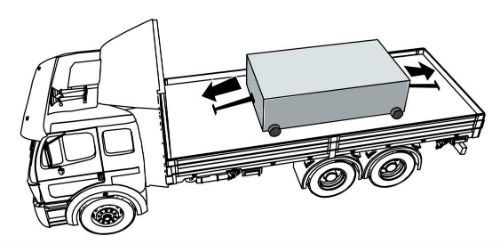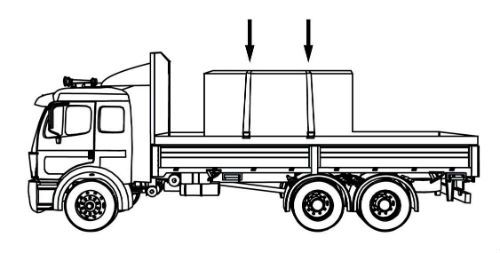CDL Practice Tests: Flatbed Cargo Securement
Choose A Section:
Go!A stack of shortwood loaded lengthwise can be secured with one tiedown if:
- They are blocked in the front by a headboard or another stack of logs.
- All of these apply.
- They are blocked in the back by the vehicle's end structure or another stack of logs.
- All logs in the stack are less than 10 ft long.
One tiedown
A stack can be secured with one tiedown if all logs in the stack less than 3.04 m (10 ft) are:
- Blocked in the front by a headboard strong enough to restrain the load or by another stack of logs.
- Blocked in the rear by the vehicle's end structure or another stack of logs.
When securing concrete pipe over 45 inches loaded crosswise, which direction must the tiedowns on the front half of the load run?
- It doesn't matter
- Straight up and down
- Forward
- Rearward
Requirements for securing the pipe
Secure each pipe with tiedowns through the pipe.
Run at least one tiedown through each pipe in the front half of the load. This includes the middle one if there are an odd number. The tiedown must run rearward at an angle not more than 45░ with the horizontal when viewed from the side of the vehicle, whenever practicable.
Run at least one tiedown through each pipe in the rear half of the load. The tiedown must run forward at an angle not more than 45░ with the horizontal when viewed from the side of the vehicle, whenever practicable. This holds each pipe firmly in contact with adjacent pipe.
When securing rolls of paper with eyes vertical, how many points of contact are required to consider a roll secure?
- 2
- 1
- 3
- 4

Usually the roll is secure if a paper roll has 3 well-separated points of contact with the vehicle, other rolls, or other cargo.
What is the minimum Working Load Limit for the entire securement system?
- 50% of cargo weight.
- 80% of cargo weight.
- 20% of cargo weight.
- 100% of cargo weight.
Note: The minimum WLL requirement for the securement system is 50%. More tiedown capacity should be used if you need to secure an article against any movement.
Which of the following is not a requirement for shortwood loaded lengthwise?
- Heavier logs must be stacked on top.
- Must be cradled in a bunk or contained by stakes.
- Logs should be centered in the bunk.
- Each outside log bearing against stakes should extend at least 6 in beyond the stakes at each end.
Requirements for shortwood loaded lengthwise
- Shortwood must be cradled in a bunk or contained by stakes.
- Logs should be centered in the bunk.
- Each outside log bearing against stakes should extend at least 0.15 m (6 in) beyond the stakes at each end.
The North American Cargo Securement Standard cover vehicles weighing:
- Less than 10,000 lbs
- 26,001 lbs
- Over 4,500 lbs
- Over 10,000 lbs
North American Cargo Securement Standard
What does the Standard cover? (Section 1.1)
- Commercial vehicles (including a combination of vehicles) that are operated on a highway and have a gross vehicle rating over 4,500 kg (10,000 lb.)
Vehicles
When securing building materials, how many knots are acceptable in the tiedown(s)?
- 2
- Depends on the weight of the cargo.
- 1
- 0
Requirements for Securement System:
- In proper working order with no damaged or weakened components that affect their performance or reduce their working load limit.
- No knots.
- Attached and secured in a manner that prevents them from coming loose during transit.
- Able to be tightened by a driver of an in-transit vehicle.
- Located inboard of rub rails whenever practicable.
- Edge protection must be used when a tiedown would be subject to abrasion or cutting.
Which of the following is not a requirement of wood used as blocking or bracing?
- It should be free of decay and structural defects.
- Hardwood is recommended.
- It should be painted.
- It should be properly seasoned.
If wood is used:
- Hardwood is recommended.
- It should be properly seasoned.
- It should be free from rot or decay, knots, knotholes, and splits.
The load carrying area of a truck, trailer, or intermodal container is referred to as the:
- Deck
- Bulkhead
- Headboard
- Well
Deck:
The load carrying area of a truck, trailer, or intermodal container.
If the cargo is fully contained in a sided vehicle, what is the minimum requirement for withstanding sideways force?
- 0.8g (80% of cargo weight)
- 0.2g (20% of cargo weight)
- 0.7g (70% of cargo weight)
- 0.5g (50% of cargo weight)
Note: If the cargo is contained in a sided vehicle, the vehicle structure MUST be strong enough to withstand the forces described earlier.
- Forward force: 0.8 g (80%)
- Rearward force: 0.5.g (50%)
- Sideways force: 0.5 g (50%)
About The Flatbed Cargo Securement CDL Manual
Studying the flatbed cargo securement CDL manual is not a requirement for getting your CDL permit or license. It is required knowledge for flatbed drivers.
Some questions you should be able to answer for flatbed cargo securement:
- What is the minimum Working Load Limit of a tiedown used to secure logs?
- What is the minimum weight of a shipment of paper rolls that would require specific securement requirements?
- When securing concrete pipe over 45 inches loaded crosswise, which direction must the tiedowns on the front half of the load run?
- What is a cab shield?
- When securing concrete pipe over 45 inches loaded crosswise, which direction must the tiedowns on the rear half of the load run?
- What is a dunnage bag?
- Who is responsible for inspecting securing devices and cargo within the first 50 miles?
- How many tiedowns are required on a stack of shortwood loaded crosswise?
- What is the minimum working load limit of each tiedown used to secure crushed or flattened vehicles?
- Define 'bolster'
- What is a hook-lift container?
- When a tiedown is attached directly to the cargo, what is the ideal angle where it attached to the vehicle?
What is a securing device?
Any device specifically manufactured to attach or secure cargo to a vehicle or trailer:
- Synthetic Webbing
- Chain
- Wire rope
- Manila rope
- Synthetic rope
- Steel strapping
- Clamps and latches
- Blocking
- Front-end structure
- Grab hooks
- Binders
- Shackles
- Winches
- Stake pockets
- D-rings
- Webbing ratchet
- Bracing
- Friction mat
What is a tiedown?
A combination of securing devices that forms an assembly that:
- Attaches cargo to, or restrains cargo on a vehicle.
- Is attached to anchor point(s).

Some tiedowns are attached to the cargo and provide direct resistance to restrain the cargo from movement.

Some tie-downs pass over or through the cargo. They create a downward force that increases the effect of friction between the cargo and the deck. This friction restrains the cargo.
 Related Cargo Securement Terms That Every Driver Should Know:
Related Cargo Securement Terms That Every Driver Should Know:
-
Tiedown:
A combination of securing devices which form an assembly that attaches cargo to, or restrains cargo on, a vehicle or trailer, and is attached to anchor point(s).
-
Contained:
Cargo is contained if it fills a sided vehicle, and every article is in contact with or sufficiently close to a wall or other articles so that it cannot shift or tip if those other articles are also unable to shift or tip.
-
Blocking:
A structure, device, or another substantial article placed against or around an article to prevent horizontal movement of the article.
How should tiedowns be attached?
Tiedowns can be used in two ways:
-
Attached to the cargo:
- Tiedowns attached to the vehicle and attached to the cargo.
- Tiedowns attached to the vehicle, pass through or aroundan article of cargo, and then are attached to the vehicle again.
-
Pass over the cargo:
- Tiedowns attached to the vehicle, passed over the cargo, and then attached to the vehicle again.
Tiedown placement:

Place the tiedown as close as possible to the spacer.
Position the tiedowns as symetrically as possible over the length of the article.

Position the tiedowns to preserve the integrity of the article.







 TT On Facebook
TT On Facebook